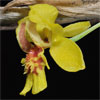|
|
|
|
|
| |
Established Seedlings of
Lockhartia lunifera 'Blanco 3219' × 'Blanco 2688' |
|
| |
|
|
| |
| Number: |
TN6899 |
| Name: |
Lockhartia lunifera 'Blanco 3219' × 'Blanco 2688'
|
| Type: |
outcross (What's that?) |
|
Seed Donor: |
Mario Blanco
|
|
Click to Enlarge

Pod Parent Flower |
Click to Enlarge

Pollen Parent Flower |
|
|
|
| |
Culture Notes from Donor: Parent plants: Temperature range CI (58-75°F)
Comments: Pod parent plant: Small plant.
Pollen parent plant: Small plant.
For additional origin/habitat information supplied courtesy of
Charles and Margaret Baker, see further below, near the bottom of this page.
|
Temperatures we attempt to use in the lab & greenhouse:
| For Species: |
|
Spring, Summer, Autumn: days average 84°F, nights 71°F; best fit is Warm 90-70°F
(Source:
Baker's Web OSC) |
| For Species: |
|
Winter: days average 74°F, nights 62°F; best fit is Cool-Intermediate 75-58°F
(Source:
Baker's Web OSC) |
|
About the name...
| Etymology of |
Lockhartia |
|
Named for English botanist David Lockhart, first director of the Botanical Garden in Port Of Spain, Trinidad (Lesser Antilles) during the 19th century.
(Source:
Mayr & Schmucker 1998) |
| Etymology of |
lunifera |
|
From Latin "lunifer" carrying a (crescent or half) moon.
(Source:
Mayr & Schmucker 1998) |
| Pronunciation of |
Lockhartia |
|
lok-HART-ee-ah
(Source:
Hawkes 1978) |
| Pronunciation of |
lunifera |
|
loo-NI-fe-ra
(Source:
Hawkes 1978) |
|
If you would like to direct someone to this web page, please copy and paste this URL into your email:
http://troymeyers.com/d?126899
|
ESTABLISHED SEEDLINGS
of these are not currently available, but we have some maturing in the greenhouse and expect to offer them in the future.
There are 3 items with
1 plant per
item that will be considered for sale later.
Click here to see if we have flasks available.
|
|
|
| |
The origin/habitat information below is supplied courtesy of Charles and Margaret Baker
The following information is based on the name of the plant provided by the donor, and assumes that the name is correct. If the plant has been misidentified, then the following information may not be correct.
This text is copyrighted by the Bakers and may not be reproduced without permission.
ORIGIN/HABITAT: Brazil. Plants usually grow in the hot, humid lowlands of
Amapá and Pará as well as the warmer lowlands of the States of Espírito
Santo, Rio de Janeiro, São Paulo, Santa Catarina, and Rio Grande do Sul,
but they are occasionally found in the cooler mountains. Specific habitat
elevations were not reported, so the following climate table and cultural
suggestions are based on estimated elevations and should be used somewhat
cautiously.
More about this information and the Bakers...
|
|
|
| |
|
|
|